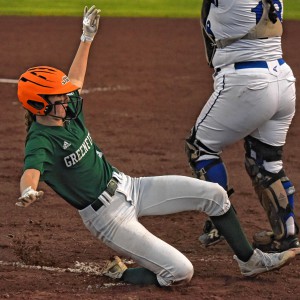Speaking of Nature: Fly meets flower: The hover fly and St. John’s wort aren’t pesky at all
| Published: 07-24-2023 5:00 AM |
Today we have a two-fer and it is all thanks to a wondrous change in the weather. I’ve complained about it before and I will complain about it again; the first two weeks of July were just a complete mess. Rain, smoke, rain, more rain and then… more rain. I am guessing that I am not alone in my feelings about the weather and the sense of cabin fever that I was starting to experience. But that changed with in week three when the sky cleared and the humidity abated.
I went out early on one of those beautiful mornings and made sure to maximize my outdoor time while I had the chance. I spent a couple hours quietly communing with the birds in my Thinking Chair at the edge of my meadow and then I decided to take a pleasant stroll back up the hill with flower photography as my goal. My special close-up lens (called a macro lens) had been brought along with flowers in mind and I happily swapped out the big telephoto lens for the smaller one.
I have a collection of trails that I established in and around my meadow and this makes flower photography particularly easy. Lots of edges provide lots of opportunities to bump into this species, or that, but the interesting thing about today’s photo is that it wasn’t taken in an “exotic” setting (such as a wet meadow). No, this one was taken in the far more humble position of a patch of unmowed vegetation over by my woodpile, which is located at the back of my garage. It just goes to show that you can find all sorts of interesting things right in your own back yard.
The flower that initially caught my attention was a golden, five-petaled beauty called common St. John’s wort (Hypericum perforatum). Described as a “common weed of fields and waste places,” by Newcomb’s Wildflower Guide, this is indeed the same plant that you may recognize from the herbal remedy section of your local pharmacy. This plant has been used as a treatment for a variety of ailments since the time of the ancient Greeks and it came over with the European colonists. Today, it is considered an intorduced species, but not an invasive one.
The thing I like most about this photograph is the clear detail on the multiple stamens that this flower has. Stamens are the structures that produce pollen (full of male gametes) and St. John’s wort is known to have as many as 20 stamens per flower. Each stamen has a black spot in the middle and I think it gives the overall flower a nice look. I also like the fact that I found flowers that had dewdrops on the petals.
As I was working on moving from one set of flowers to another, I happened to notice that a hover fly (Family Syrphidae) was showing some interest in the very same flowers. So, I switched gears into insect mode and started taking photos as the little fly tried to decide if there was any pollen or nectar available. These flies are sometimes called “flower flies” because the adults find their food in flowers.
Interestingly, they also show a beautiful display of mimicry. Little flies that visit flowers might not be “bothered” if they look like little wasps, and that is exactly what hover fly coloration tries to do.
Now, when it comes to identifying an exact species, there is a definite challenge. There are 6,000 species of hover flies in the world and more than 800 species in North America. They are broken up into many different genera, but it basically comes down to the exact shape and coloration of the stripes on the flies’ abdomens. Thicker or thinner black lines makes a difference. Straight lines or curved lines makes a difference. All of it matters and then an identification can be attempted.
Article continues after...
Yesterday's Most Read Articles
 Greenfield homicide victim to be memorialized in Pittsfield
Greenfield homicide victim to be memorialized in Pittsfield
 1989 homicide victim found in Warwick ID’d through genetic testing, but some mysteries remain
1989 homicide victim found in Warwick ID’d through genetic testing, but some mysteries remain
 As I See It: Between Israel and Palestine: Which side should we be on, and why?
As I See It: Between Israel and Palestine: Which side should we be on, and why?
 Softball: Greenfield puts up 9-spot in the 8th inning to knock off rival Turners 11-2 in extra-inning thriller (PHOTOS)
Softball: Greenfield puts up 9-spot in the 8th inning to knock off rival Turners 11-2 in extra-inning thriller (PHOTOS)
 DA to announce breakthrough in 1989 unsolved homicide in Warwick
DA to announce breakthrough in 1989 unsolved homicide in Warwick
 Former Greenfield man granted new trial after 1995 murder conviction, walks free
Former Greenfield man granted new trial after 1995 murder conviction, walks free
So, before I share my identification with you I need to remind you that I am a “bird guy.” However, in my ever-expanding private library I have many books on insects and after plenty of time comparing the markings on this fly to the different markings found in my books, I think I am fairly comfortable identifying this species as the eastern calligrapher (Toxomerusgeminatus). What a name! A gorgeous little fly with a spectacular name is a great combination.
The nice thing about hover flies is the fact that the larvae of some species are predatory and will seek out aphids as a food source. Thus, the eastern calligrapher will be a gardener’s best friend. Keeping this in mind, try not to take a swing at this fly if it is hovering about you as you work outside. Hover flies seem to be somewhat curious and will often approach people for no reason at all. They may be black-and-yellow, but they merely look dangerous. They cannot harm you in any way and if you can relax a little, then you may find that one of these wonderful little insects will spend some time with you. One might even land on you and rest for a bit before heading off in search of more pollen and nectar to fuel its busy little life.
Bill Danielson has been a professional writer and nature photographer for 26 years. He has worked for the National Park Service, the US Forest Service, the Nature Conservancy and the Massachusetts State Parks and he currently teaches high school biology and physics. For more in formation visit his website at www.speakingofnature.com, or go to Speaking of Nature on Facebook.
]]>

 Speaking of Nature: Indulging in eye candy: Finally, after such a long wait, it’s beginning to look like spring is here
Speaking of Nature: Indulging in eye candy: Finally, after such a long wait, it’s beginning to look like spring is here Celebrating ‘Seasonings’: New book by veteran preacher and poet, Allen ‘Mick’ Comstock
Celebrating ‘Seasonings’: New book by veteran preacher and poet, Allen ‘Mick’ Comstock Faith Matters: How to still the muddy waters of overthinking: Clarity, peace and God can be found in the quiet spaces
Faith Matters: How to still the muddy waters of overthinking: Clarity, peace and God can be found in the quiet spaces A time for every purpose under heaven: Free sing-a-long Pete Seeger Fest returns to Ashfield, April 6
A time for every purpose under heaven: Free sing-a-long Pete Seeger Fest returns to Ashfield, April 6
